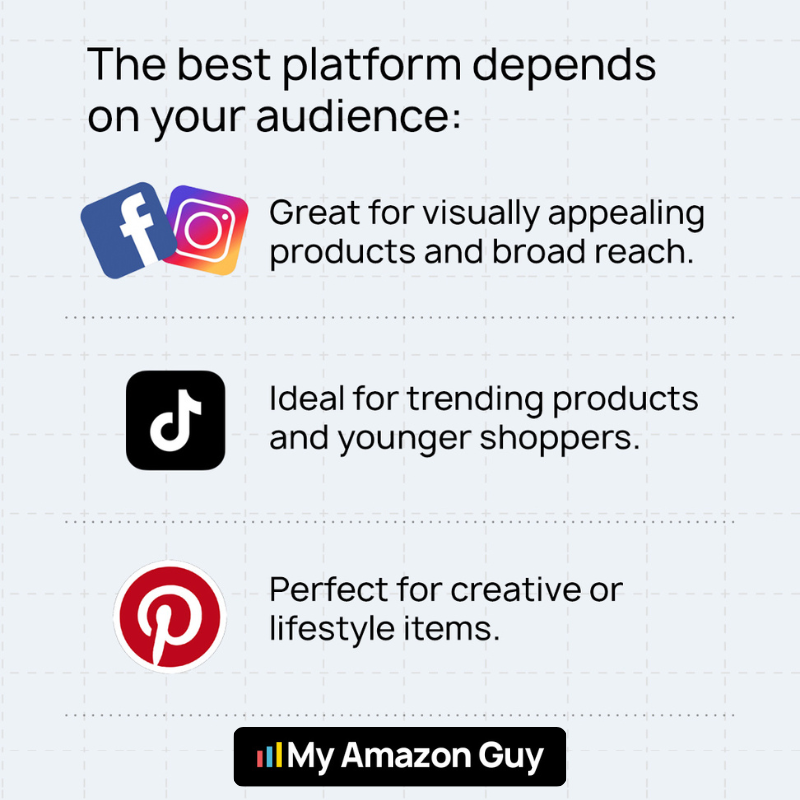Do you ever wonder how some shoppers discover your brand before buying it on Amazon? Often, it starts with exposure outside Amazon, through ads, influencers, or content, and this influence is known as the Amazon Halo Effect.
Advertising within Amazon is powerful because you appear right where shoppers are ready to buy. But what about the shoppers who don’t visit Amazon every day, or those who first discover your brand outside the platform?
These potential customers make up a huge audience that’s often overlooked. By running DTC marketing campaigns, you can build awareness that eventually funnels shoppers to your Amazon listings.
In this guide, we’ll break down the Amazon Halo Effect and explain how DTC marketing campaigns can influence shoppers to complete their purchases on Amazon. We’ll also discuss practical strategies and tracking tools sellers can use to improve attribution, optimize product detail pages, and strengthen their Amazon brand.
Table of Contents
Win on Both Fronts
Your DTC ads fuel Amazon sales. Learn how to align campaigns and product listings for maximum results.
What Is the Amazon Halo Effect and How Does It Work?
The Amazon Halo Effect happens when customers first see your brand in a DTC channel but end up completing their purchase on Amazon. Since Amazon is trusted for fast shipping and convenience, it becomes the final stop for many shoppers.
With the right DTC marketing strategies, you can spark brand awareness that eventually lifts your Amazon sales. Even if the sale isn’t directly attributed to the ad, the demand it creates is still captured by your Amazon listings.
Take the skincare brand Nécessaire, for example. On Prime Day, 65% of their sales came organically from DTC demand, proving how powerful it is to build customer demand outside the platform and let it spill over into higher sales, even during high-competition events like Prime Day.
5 DTC Marketing Strategies That Drive Amazon Demand
There are a bunch of DTC marketing strategies that can spark brand awareness and influence how shoppers discover your products. Each one of these strategies can benefit your Amazon sales by creating more demand for your listings that are ready to capture.
1. Social Media Ads
With more than 5 billion people worldwide using social media, it only makes sense to use these platforms to market your products. Running ads on TikTok, Instagram, or Facebook helps you grab attention where people already spend their time and then guide them toward making a purchase on Amazon.
The key is creating engaging, authentic content that sparks curiosity instead of just running traditional sales ads. From short TikTok demos to Instagram reels, social media ads can build awareness that ultimately drives shoppers to search for your brand and buy from your Amazon listings.
2. Paid Search Marketing
Just like on Amazon, sellers can run paid search campaigns on platforms like Google to put their products in front of people actively looking for solutions. By targeting the right keywords, you can capture shoppers who are searching for products similar to yours and introduce them to your brand before they even land on Amazon.
This strategy is powerful because many of those shoppers will still choose to complete their purchase on Amazon for convenience. Paid search not only boosts your DTC site traffic but also creates brand recognition that turns into more Amazon searches, clicks, and sales.
3. Influencer Marketing
When consumers see your product being used by their favorite influencer, they’re more likely to look for it on Amazon because they trust that recommendation. Nearly half of social media users admit that influencer content impacts their buying decisions, which means your brand can gain exposure far beyond ads alone.
To make this work, reach out to influencers who already post content in your niche and can authentically show off your product. Whether it’s a quick TikTok video, an Instagram post, or even an Amazon Live stream, their endorsement can drive curious shoppers to search for your brand on Amazon and increase your sales.
4. Email Marketing
Although some sellers think email marketing is “old school”, it’s still one of the most effective ways to get shoppers to check out your Amazon listings. A well-timed email with a discount, restock alert, or early access to deals can remind customers about your products and push them straight to your brand store.
Emails also help keep your brand top of mind even when customers aren’t on Amazon. By building your own list, you can consistently reach buyers, highlight promotions, and send them directly to your Amazon pages whenever you want.
5. User-Generated Content (UGC)
UGC is the content that comes directly from customers, things like reviews, photos, videos, and testimonials. Because it’s authentic and relatable, UGC carries more weight than brand-created ads and can heavily influence buying decisions.
Fact is, UGC fuels the Amazon halo effect by showing first-hand experiences that build trust and reduce doubts about a purchase. Encourage your customers to share their feedback on social media or product pages, and you’ll create social proof that attracts even more shoppers to your Amazon listings.
Boost Your DTC Impact on Amazon
Turn your off-Amazon campaigns into Amazon sales with smarter attribution and PDP optimization.
Why Sellers Struggle to Attribute DTC Campaigns to Amazon Sales
One of the hardest parts of being an Amazon seller is figuring out which marketing efforts are moving the needle. Amazon keeps its sales data locked up, so sellers often feel like they’re guessing when it comes to connecting outside campaigns with actual Amazon results.
The challenge gets even bigger with cross-channel attribution, since a shopper might see your product on TikTok, research it on Google, then finally buy it on Amazon. That messy customer journey makes it tough to know what’s really driving sales and brand visibility.
How to Know Which Channels Your Amazon Sales Are Coming From
Even though there’s no single perfect way to measure how DTC efforts impact Amazon sales, sellers can use different tools and indicators to track performance. These insights can reveal which channels are driving results and help guide smarter budget decisions.
1. Seller Central Reports
One of the first places sellers should check is Business Reports inside Seller Central. These reports let you dig into sales, orders, and traffic for each ASIN, giving you a clear snapshot of how shoppers are engaging with your listings.
By filtering data by date ranges and exporting it, you can compare results against your DTC campaigns running at the same time. If you see a spike in page views or conversion rates for products you promoted off-Amazon, that’s a strong signal your external efforts are driving Amazon sales.
2. Amazon Attribution
Amazon Attribution is a free tool that lets sellers track which off-Amazon channels, like social media, email, or search ads, are actually driving traffic and sales on Amazon. By creating unique tracking tags for each campaign, sellers can see customer behavior from the first click all the way to checkout.
Inside the reports, you’ll find metrics such as clicks, impressions, add-to-carts, and conversions tied to each channel. With this data, you can figure out which DTC campaigns are moving the needle on Amazon sales and shift your budget toward the ones delivering the best ROI.
3. Amazon Associates Program
The Amazon Associates program gives sellers a way to track clicks and sales coming directly from their own affiliate links. By placing these links in ads, emails, blogs, or social posts, you can see which DTC campaigns are pushing shoppers over to your Amazon listings.
Inside the Associates dashboard, the Orders Report shows data on clicks, dispatched items, and conversion rates tied to each link. This makes it easier to figure out which platforms or content types are sending quality traffic, so you can double down on what’s working and cut out what’s not.
4. Third-Party Seller Tools
Third-party tools like Jungle Scout can give sellers deeper insights into sales performance, competitor activity, and keyword trends. While these platforms aren’t designed to directly track DTC traffic, they can highlight product performance shifts that suggest your outside marketing is influencing Amazon sales.
There are also tools that allow you to integrate Amazon data with Google Analytics, email platforms, and social dashboards for a fuller view. This type of integration makes it easier to connect the dots between a TikTok campaign, a spike in branded searches on Amazon, and an increase in conversions.
Frequently Asked Questions
What are the disadvantages of the Amazon Halo Effect?
The main challenge is attribution. You’re building brand awareness and driving demand, but because the final sale happens on Amazon, it can be difficult to prove the direct ROI of your off-platform marketing efforts without the right tools, leading to potential under-investment in brand-building.
What is the evidence for the Amazon Halo Effect?
The evidence comes from how selling on Amazon often boosts visibility for an entire catalog when one product performs well. For example, high-ranking or trending products can push customers to browse more items from the same Amazon brand, showing how success in one area spills over to others.
How can sellers improve results from the Amazon Halo Effect?
To improve outcomes, sellers should optimize product detail pages with strong images, keywords, and reviews. Maintaining a consistent brand experience across all listings helps strengthen the Amazon brand presence and ensures traffic converts into sales.
Making the Amazon Halo Effect Work for You
The Amazon halo effect can be a powerful driver of sales when used strategically. By focusing on optimizing product detail pages, building a strong Amazon brand, and running smart ad campaigns, sellers can turn this effect into a steady growth engine.
Still, the halo effect isn’t without its challenges. Over-reliance on a single product or ignoring how other listings contribute to overall sales can create blind spots that limit growth opportunities.
Are you looking for an expert who can also help you with your DTC marketing? Reach out to our full-service Amazon agency and let our experts improve your strategy, boost visibility, and scale your business with confidence.
Track What Really Works
Don’t guess which campaigns drive Amazon sales. Use attribution tools to measure the Halo Effect.





